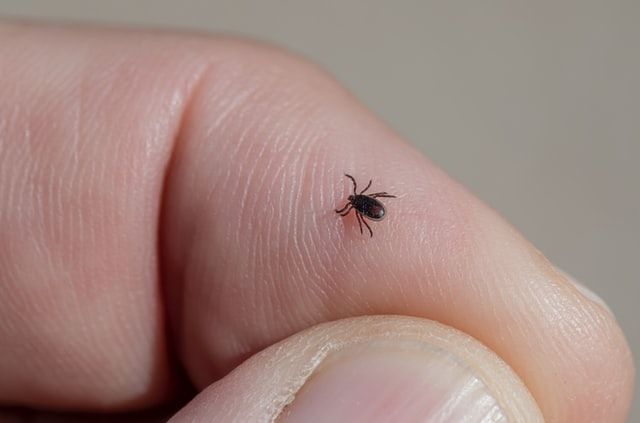
Get “Ticked” Off and Fight Lyme Disease
Do you enjoy hiking in the woods? Be sure to follow some easy preparations to protect yourself against Lyme disease, which is transmitted by the ever-more common deer ticks. According to the CDC, Lyme disease is the most common vector-borne disease in the United States. NPR reports that Lyme disease infects an estimated 476,000 people a year nationally.
The upper Midwestern and the Northeastern United States are the most common areas for Lyme disease. Although, northern California, Oregon, and Washington also reported cases.
The bacterium Borrelia burgdorferi and, rarely, Borrelia mayonii cause the disease. It is transmitted to humans through the bite of infected black-legged or deer ticks.
It's essential to know how to prevent a tick bite, identify and remove ticks, recognize the symptoms, and seek treatment.
- Avoid grassy, brushy, or wooded areas. Walk in the center of the trail to avoid brush and grass.
- Use insect repellent with DEET.
- Treat your clothing and gear with 0.5 percent permethrin.
- Wear light-colored clothing to help spot tiny deer ticks.
- Tuck your long sleeve shirt into your pants and your pant legs into your socks.
- Check yourself, your children, and your pets daily for ticks. Carefully remove any ticks you find.
- Take a shower and wash and dry your clothes at high temperatures after being outdoors.
Tick Removal
- Use clean, fine-tipped tweezers to grasp the tick as close to the skin's surface as possible.
- Pull upward with steady, even pressure. Don't twist or jerk the tick or this can cause the mouth parts to break off and remain in the skin. If this happens, remove the mouth parts with tweezers. If you cannot remove the mouth easily with tweezers, leave it alone and let the skin heal.
- After removing the tick, thoroughly clean the bite area and your hands with rubbing alcohol or soap and water.
- Never crush a tick with your fingers. Flush the tick down the toilet.
Signs and Symptoms of Lyme Disease
These are some of the signs and symptoms to watch out for after spending time in the woods or other areas that may have ticks.
- Fever, chills, headache, fatigue, muscle and joint aches, and swollen lymph nodes
- Erythema migrans (EM) rash:
- Occurs in approximately 70 to 80 percent of infected persons
- Begins at the site of a tick bite after about 7 days
- Expands gradually reaching up to 12 inches or more across
- It may feel warm but is rarely itchy or painful
- Often results in a "bulls-eye" appearance
Diagnosis
Diagnosis can be difficult as many signs of Lyme disease are also observed in other conditions. If you don't have the characteristic Lyme disease rash, your doctor might ask about whether you've been outdoors.
Lab tests to identify antibodies to the bacteria can help confirm or rule out the diagnosis. These tests are most reliable a few weeks after infection when your body has had time to develop antibodies. They include:
- Enzyme-linked immunosorbent assay (ELISA) test is used most often to detect Lyme disease. It detects antibodies to B. burgdorferi, but it can provide false-positive results, so it's not used as the only diagnostic.
- Western blot test. If the ELISA is positive, this test is done to confirm the diagnosis. It detects antibodies to Lyme disease, however, it doesn't actually test the bacteria itself.
Treatment
Lyme disease is treated with antibiotics. The earlier you are treated, the better.
After treatment, some patients may still have pain, fatigue, or difficulty with thinking that can last more than six months. This is called post-treatment Lyme disease syndrome (PTLDS). Unfortunately, there is no proven treatment.
Chronic Lyme Disease (CLD) Controversy
Unlike PTLDS patients, CLD patients are those who have never had the characteristic bulls-eye rash or received a reliable positive laboratory test. However, they maintain Borrelia burgdorferi is responsible for a range of debilitating chronic symptoms they experience.
For years CLD patients were told by physicians that their diagnosis was fictitious. However, in 2019, the International Lyme and Associated Diseases Society (ILADS) provided the following evidence-based definition:
CLD is a multisystem illness with a wide range of symptoms and/or signs that are either continuously or intermittently present for a minimum of six months. The illness is the result of an active and ongoing infection by any of several pathogenic members of the Borrelia burgdorferi sensu lato complex (Bbsl).
The ILADS conducted a systematic review of over 250 peer-reviewed papers in the international literature to characterize the CLD clinical spectrum. Their definition clarifies the term's meaning. The literature review validates that chronic Bbsl infections can result in chronic disease.
This definition should promote a better understanding of CLD and facilitate future research.
Research and materials for this article were compiled, written, and distributed on behalf of the National Public Health Information Coalition. The views and opinions expressed in this blog are those of the various authors and do not necessarily reflect the official policy or position of the National Public Health Information Coalition or its members.
References:
Lyme Disease | Lyme Disease | CDC
How many people get Lyme disease? | Lyme Disease | CDC
DEET General Fact Sheet (orst.edu)
Permethrin General Fact Sheet (orst.edu)
The Western Blot Test And Lyme Disease - Tired of Lyme
Post-Treatment Lyme Disease Syndrome | Lyme Disease | CDC
Chronic Lyme Disease | NIH: National Institute of Allergy and Infectious Diseases
Chronic Lyme Disease: An Evidence-Based Definition by the ILADS Working Group - PMC (nih.gov)

